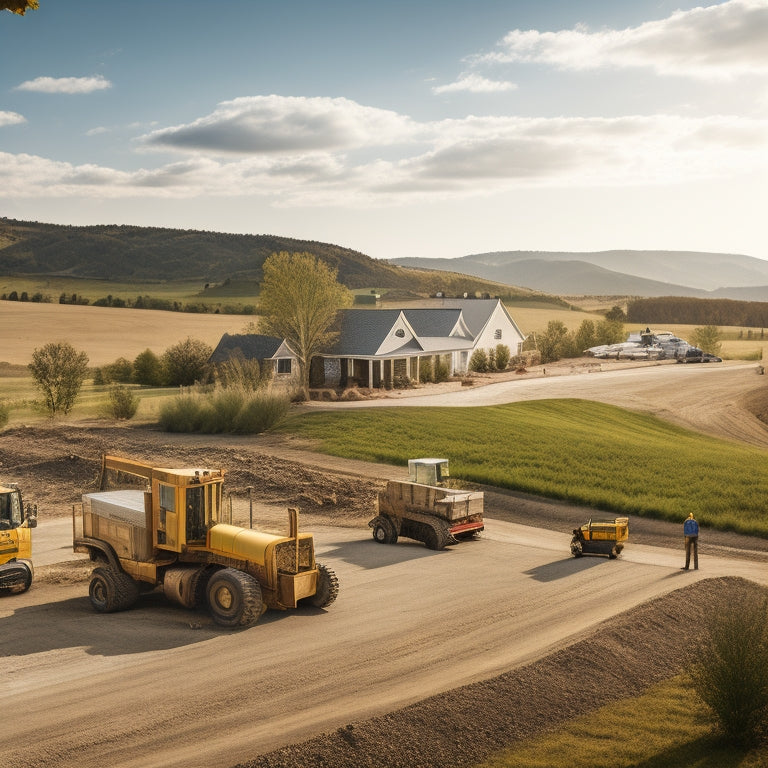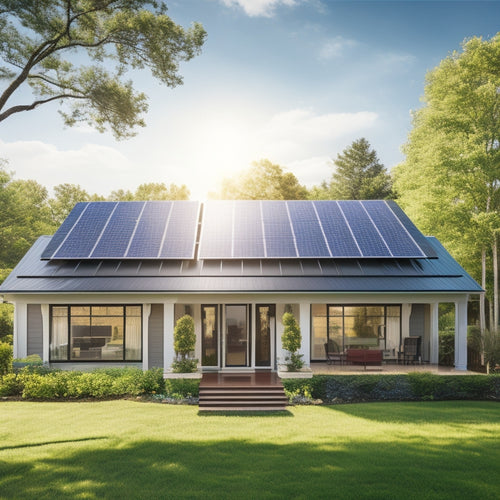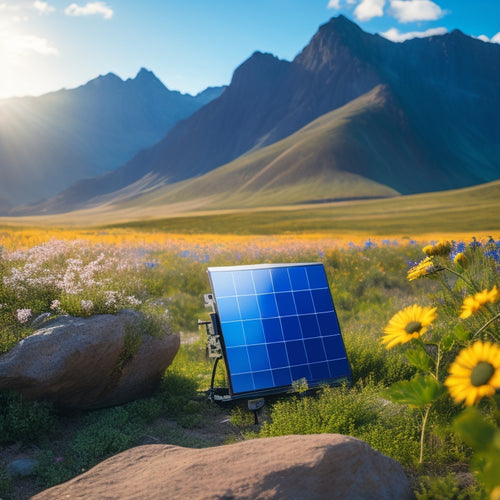
Rural Homes: A Step-by-Step Installation Guide
Share
You're about to install solar panels on your rural home, congratulations! First, assess your energy needs by calculating your daily consumption and noting appliance usage. Prepare your property by evaluating shading, checking local regulations, and inspecting your roof's condition. Choose the right equipment, including solar panels, batteries, and inverters, ensuring compatibility and peak performance. Install the panels safely, using personal protective equipment and following manufacturer's instructions. Finally, connect to the grid, obtaining necessary permits and conducting thorough testing. Now that you've started, take the next step to utilize renewable energy and improve your rural home's efficiency.
Key Takeaways
- Assess energy needs by tracking usage and selecting solar panels with appropriate system sizing for optimal performance.
- Prepare the rural property by conducting a site evaluation, checking local regulations, and inspecting the roof's condition.
- Choose the right equipment, including solar panel types, warranties, battery banks, and energy efficiency measures.
- Ensure a safe installation by identifying potential hazards, using personal protective equipment, and following manufacturer's instructions.
- Connect to the grid by obtaining necessary permits, installing a grid-tie inverter, and conducting thorough testing to ensure compliance.
Assessing Your Energy Needs
Determining your energy needs is an essential step in designing an efficient renewable energy system for your rural home.
You'll want to calculate your energy consumption to guarantee you're generating enough power to meet your daily needs. Start by tracking your energy usage over a month to get an accurate representation. Note the number of appliances, lights, and devices you use, as well as their wattage and daily usage hours. This will give you a total daily energy consumption in watt-hours (Wh).
Consider your energy goals, such as reducing reliance on non-renewable resources or going off-grid entirely.
When selecting solar panels, careful consideration of system sizing is vital, as it directly impacts the overall performance of your renewable energy system.
With this information, you can design a renewable energy system that effectively utilizes renewable resources, like solar or wind power, to meet your unique energy needs.
Preparing Your Rural Property
With your energy needs assessed, it's time to prepare your rural property for the installation of your renewable energy system. Conduct a thorough site evaluation to identify potential obstacles, such as shading from trees or nearby structures, that could impact system performance.
Check local regulations regarding setbacks, permits, and zoning restrictions to guarantee compliance. Verify that your property meets the necessary requirements for the installation of your chosen renewable energy system.
Inspect your roof's condition, confirming it's structurally sound and can support the weight of the equipment. Consider energy storage capacity to influence solar array size and account for seasonal energy needs.
Ascertain the system configuration meets identified energy needs, and allocate energy to critical loads. Clear the area around your home of any debris or obstructions to provide a safe and efficient installation process.
Choosing the Right Equipment
Your renewable energy system's performance hinges on selecting the right equipment.
You'll need to choose solar panels that suit your rural home's energy needs and climate. Consider the following factors when making your selection:
-
Solar panel types: Monocrystalline panels are efficient but expensive, while polycrystalline panels offer a balance between performance and cost. Thin-film panels are a budget-friendly option but less efficient. When selecting solar panels, verify they've a thorough warranty high-efficiency panels that covers at least 25 years.
-
Energy storage: You'll need a battery bank to store excess energy generated during the day for use at night or during power outages. Lead-acid batteries are a popular choice, but lithium-ion batteries offer higher efficiency and longer lifetimes.
Energy efficiency measures can also be implemented to lower overall consumption and reduce the load on your energy storage system.
- Inverter compatibility: Confirm your inverter is compatible with your solar panel array and energy storage system to optimize energy conversion and minimize losses.
Installing Solar Panels Safely
Now that you've chosen the right equipment for your rural home's renewable energy system, it's time to focus on installing solar panels safely.
Begin by identifying potential hazards on your roof, such as loose tiles or weak structures. Wear personal protective equipment, including a safety strap, gloves, and safety glasses, to minimize risks.
Make sure you have the necessary installation tools, like a drill, wrench, and ladder, and that they're in good condition. Always maintain three points of contact with the roof, whether it's two hands and one foot or two feet and one hand.
Follow the manufacturer's instructions for panel installation, and take regular breaks to avoid fatigue.
Connecting to the Grid
Connecting to the grid requires careful planning and execution to confirm a safe and efficient changeover from your rural home's renewable energy system to the main power grid.
You'll need to guarantee a seamless shift between your renewable energy sources and the grid's electrical supply.
To achieve this, you'll need to:
- Obtain electrical permits from your local authorities to validate your grid connection
- Install a grid-tie inverter that synchronizes your renewable energy output with the grid's frequency and voltage
- Conduct thorough testing to verify that your system meets the grid's technical requirements and safety standards
Frequently Asked Questions
Can I Install Solar Panels on My Metal Roof?
You're not alone, like the 2019 California farmhouse that successfully installed solar panels on its metal roof. Yes, you can install solar panels on your metal roof, leveraging its benefits like durability and ease of installation, with compatible solar panel types like thin-film or flexible panels.
How Do I Handle Snow Removal From Solar Panels?
You'll need to remove snow from your solar panels to maintain panel efficiency, as snow accumulation can reduce energy production by up to 90%. Use a soft-bristled brush or specialized snow rake to gently clear snow, taking care not to scratch the panels.
Are Solar Panels Resistant to Hail and Extreme Weather?
You'll be relieved to know that solar panels are designed to withstand hail damage and extreme weather conditions, boasting impressive weather durability thanks to tempered glass and sturdy frames that can resist impacts and harsh environmental stressors.
Can I Add Solar Panels to My Existing Home?
You can add solar panels to your existing home, considering installation costs and evaluating them against the solar panel benefits, such as reduced energy bills and increased property value, to make an informed decision.
Do I Need to Upgrade My Electrical Panel for Solar?
You'll likely need to upgrade your electrical panel if it can't handle the added power from solar panels, which can increase your overall solar panel costs; assess your electrical capacity to determine if an upgrade is necessary.
Related Posts
-

Why Outdoor Solar Lighting Systems Are Sustainable
Outdoor solar lighting systems are sustainable because they utilize renewable energy, drastically reducing your carbo...
-

Home Solar Installation Cost
You're considering installing solar panels on your home, and the upfront cost is likely the biggest hurdle standing i...
-

High-Efficiency Solar Battery Chargers for Remote Areas
High-efficiency solar battery chargers are essential for your off-grid energy needs in remote areas. They maximize en...


